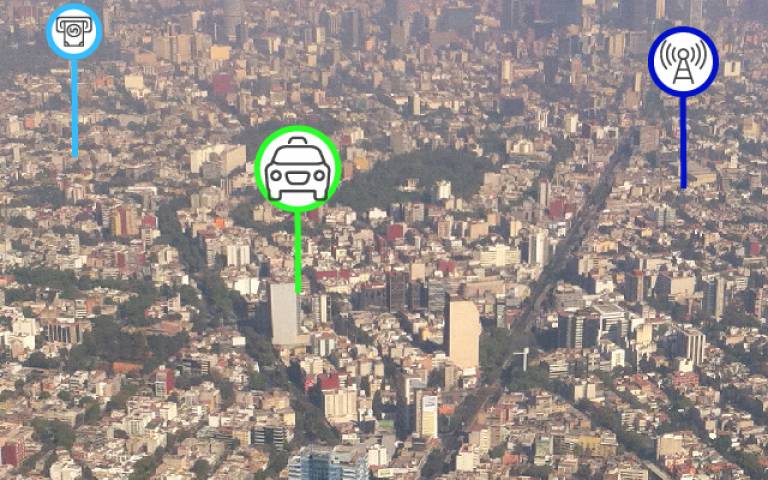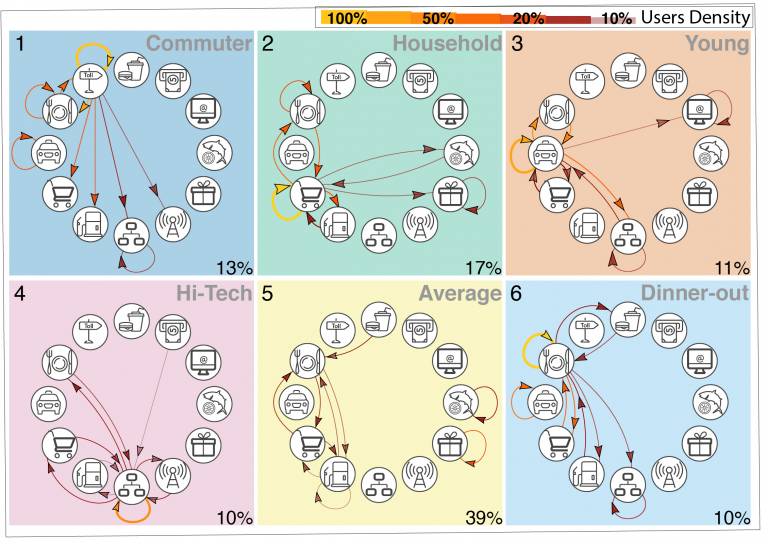Sequences of purchases in credit card data reveal lifestyles in urban populations
24 August 2018
Riccardo Di Clemente, Newton International Fellow at CASA, leads a study published in the journal Nature Communications.

Digital traces from credit card and mobile phone usage can be used to map urban lifestyles and understand human mobility. Credit Card Records (CCRs) are currently used to measure similarities in purchasing activity, but for the first-time researchers have used the data along with Call Detailed Records (CDRs) to understand the daily rhythms of human mobility and communication. Combining both reveals patterns in the socio-economic behaviors of citizens. Published in Nature Communications, the study analyzes anonymous and aggregated credit card data from a major city to group the urban population into six spending clusters with peculiar socio-economic characteristics.

Older women dominated the ‘Homemaker’ cluster and tended to have the least expenditure and mobility, with their core transaction being grocery shops. The ‘Commuters’ cluster was mainly men who lived the farthest from the city centre.
Young people can be split into two groups, with the younger having taxis as their core transaction. The slightly older group also has computer networks and information services, with a higher than average expenditure and operating mainly within the city centre.
The approach of this study brings together human mobility behavioral dynamics with socio-economic and demographic information.This may enable policymakers to make more informed decisions about resource allocations to address socio-economic inequality, economic growth and improve social cohesion.
The research, conducted in collaboration with Grandata and UN Global Pulse, is part of a wider project funded by the United Nations Foundation and the Gates Foundation to investigate the economic, social and health status of women and girls in developing countries.
The data was provided by Grandata with support from UN Global Pulse.
The leading author Dr. Riccardo Di Clemente is a Newton International Fellow at CASA.
Reference: ‘Sequences of purchases in credit card data reveal lifestyles in urban populations'. Nature Communications doi: 10.1038/s41467-018-05690-8
Authors: Riccardo di Clemente, UCL The Bartlett Centre for Advanced Spatial Analysis and MIT Department of Civil and Environmental Engineering; Marta C. Gonzalez, UC Berkeley College of Environmental Design and MIT Department of Civil and Environmental Engineering; Miguel Luengo-Oroz, UN Global Pulse; Matias Travizano, GranData; Sharon Xu, MIT Department of Civil and Environmental Engineering; Bapu Vaitla, Harvard University Department of Environmental Health
The paper forms part of Big Data and the Well-Being of Women and Girls: Applications on the Social Scientific Frontier, published by Data2x and funded by the Gates Foundation and the UN Foundation.
Abstract:
Zipf-like distributions characterize a wide set of phenomena in physics, biology, economics and social sciences. In human activities, Zipf-laws describe for example the frequency of words appearance in a text or the purchases types in shopping patterns. In the latter, the uneven distribution of transaction types is bound with the temporal sequences of purchases of individual choices. In this work, we define a framework using a text compression technique on the sequences of credit card purchases to detect ubiquitous patterns of collective behavior. Clustering the consumers by their similarity in purchases sequences, we detect five consumer groups. Remarkably, post checking, individuals in each group are also similar in their age, total expenditure, gender, and the diversity of their social and mobility networks extracted by their mobile phone records. By properly deconstructing transaction data with Zipf-like distributions, this method uncovers sets of significant sequences that reveal insights on collective human behavior.

 Close
Close

